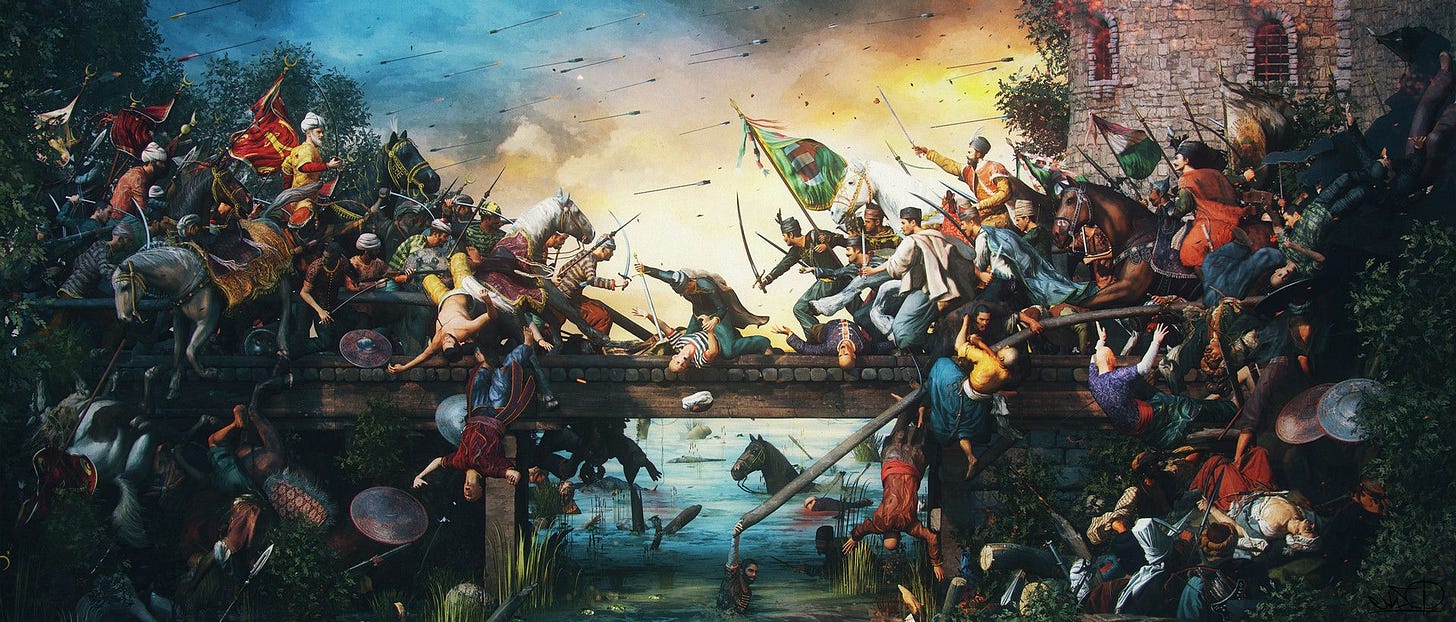The Ottoman apogee
Review of Suleiman the Magnificent by Andre Clot
This is a popular historical introduction to one of the greatest Turkish leaders, Suleiman, called The Magnificent by his European adversaries. During his reign (1520–1566), not only did the Ottoman Empire reach its greatest territorial extent and richness, but he also sowed the seeds of its subsequent decline over the next 300 years. While he ruled, many feared that he would conquer a squabbling and fractured Western Europe (particularly with the Reformation wars), that his unequalled military machine was unstoppable.
Suleiman inherited and refined a military state that was greater than any since the Roman Empire of the West and the Mongolian Empire in the east. It was a meritocracy based on a kind of temporary aristocracy that was granted domains in exchange for military service as cavalry when needed; their position was non-inheritable and based exclusively on service and achievement, so easily revoked. The Ottoman state also systematically searched for talent, often non-Muslim in origin, for absorption and education to serve the Empire as administrators or the elite fighting force, the Janissaries. Together with occasional fighters of the lower classes, they formed the most disciplined military force then in existence; they also had cutting-edge military technology, especially ordinance, but soon ships.
At the start of Suleiman‘s reign, the Empire was poised for a major expansion on 4 fronts: into Central Europe, Northern Africa/Arabia, Persia, and the Mediterranean. It was the world's greatest naval power. For many years, it appeared that Suleiman would win on all fronts as victory followed victory. With each new territory came extraordinary riches, so that his treasury was full to overflowing. However, by overextending his forces, the Empire reached the point of natural maximum expansion. That was the beginning of the decline: without new territories from which to extract resources as booty, local potentates had to raise taxes within the Empire's borders to sustain it.
In addition, there was a problem of succession, with several competent heirs executed (justly or unjustly, it is impossible to know), so that Selim the Sot was the only one left to take over, at a time when dynamic leadership was required to internally transform the Empire fundamentally. Suleiman also had brought the Harem permanently into the palace, due to his attachment to Roxeline, which brought intrigues to the center of the government, with catastrophic consequences for the delicate balances of competent provincial administrators and fair treatment of subjects. Finally, the system of temporary aristocracy became hereditary, based more on privilege rather than military merit.
This eventually led to legendary corruption and a slow disintegration right at the moment that Western Europe was modernizing its technologies of transport (with the oceans rather than the Mediterranean as their trade routes), its military science, and the creation of a new dynamism in its mercantilist economies (with trade surpluses to invest) that developed later into industrial capitalism, as based on the mobilization of entire nations and with investments financed by foreign exchange. Having never established an Atlantic port, Turkey was left behind by all these developments, to become the "sick man" of Europe when all the systems that had once worked so well became deadly liabilities.
Unfortunately, the reader does not get much of a feel for Suleiman as a person, except for his domination by Roxeline and his modesty as reflected in his poetry. Moreover, the book is a popularization that is based almost entirely on secondary sources – Clot breaks no new ground and offers very few primary-source quotes to flavor his story. Finally, the footnotes are rare and uninteresting, which for me means that the book is not at all intended for scholars (not that I am one, but footnotes offer certain pleasures that I missed).
In spite of these criticisms, this book is a very good read. I finished it wanting to learn more about the period, always the best sign of success for me. Indeed, understanding Suleiman is key to understanding the development of European modernism after the Renaissance; his threat may have enabled the Protestant states to establish themselves as viable political entities.
Related reviews:
Selim the Grim, his times, and the Ottoman version of Islam
This is a very fun biography on the brief reign of a political genius whose cultural impact was wide and deep, with resonances even today in Erdogan’s Turkey and Islamophobia. It is a quick read, with both an interesting narrative and an analysis that fleshes out how the people of his time saw the world. Even as a history enthusiast well acquainted with…
Delightful, fascinating, and deep
This book offers a stark contrast to Kinross' The Ottoman Centuries. Kinross' book is dry, stuffily pedantic, and laden with the details of obscure territorial skirmishes. While I learned the outlines of Ottoman history in Kinross, it was this book that gave me a true flavor for that vanished world – who the people were, why they acted the way they did,…
How the Ottoman Empire held together for 600 years
The Ottoman Empire lasted from the 14th century to World War I. It was multi-ethnic and enjoyed extended periods of peace in which its peoples could live in relative freedom and even prosper. How did its society work? Could it be taken as an example to emulate? What lessons are relevant for today?
Standard diplomatic history with little analysis and even less on culture
The Ottoman story is remarkable: founded in the 13th century, a small tribe began to build an empire in Central Asia and expanded into Byzantine territory, stopping at the gates of Vienna in 1529. Conquering large swaths of territory in North Africa and the Arabian peninsula, it had expanded unchecked for 200 years, became a sea power, controlling most …







